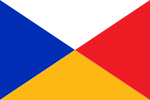MS Pride of Kent
 Pride of Kent approaching Calais | |
| History | |
|---|---|
| Name: |
|
| Owner: |
|
| Operator: | P&O Ferries |
| Port of registry: |
Dover, |
| Route: | |
| Builder: | Schichau Unterweser AG, Germany |
| Yard number: | 1073 |
| Launched: | 14 December 1991 |
| Completed: | 12 June 1992 |
| Maiden voyage: | 16 June 1992 |
| Identification: | IMO number: 9015266 |
| Status: | In Service |
| General characteristics | |
| Tonnage: |
|
| Length: | 179.7 m (589.6 ft) |
| Beam: | 28.3 m (92.8 ft) |
| Draft: | 6.27 m (20.6 ft) |
| Installed power: | 4 x Sulzer 8ZA40S Diesels |
| Propulsion: | Two controllable pitch propellers |
| Speed: | 21 knots (39 km/h; 24 mph) |
| Capacity: |
|
MS Pride of Kent is a cross-channel ferry operated by P&O Ferries, which since 2003 has operated on the Dover to Calais route. Before that, between 1992 and 2002, it operated on the Dover to Zeebrugge route.
History
Colloquially known as Kent, she was built as European Highway in 1991, a sister ship to the MS Pride of Canterbury, and MS European Seaway. Originally servicing Zeebrugge, like Pride of Canterbury, she was converted in 2003 before re-entering service on the Dover–Calais route as Pride of Kent.
She is the second ship to bear the name — MS Spirit of Free Enterprise,but was later renamed Pride of Kent in 1987 (later P&OSL Kent in 1998 and PO Kent in 2002) and continued to sail the Dover-Calais route until 2003.[1]
Project Darwin
With the ending of the P&O Stena Line agreement, newly formed P&O Ferries announced that the ex Zeebrügge freight vessels European Highway and European Pathway would be rebuilt at the German Shipyard of Lloyd Werft. On completion of their rebuilds, they would be placed on the premier Dover-Calais service, replacing PO Kent (ex-Spirit of Free Enterprise, Pride of Kent, then POSL Kent) and PO Canterbury (ex-Stena Fantasia). This move became widely known by its P&O in-house code name, Project Darwin. Key features of the converted ships were:
- Passenger capacity up from 200 to 2,000
- More than 5,000 square metres of passenger accommodation
- Fifty extra crew cabins
- Better manoeuvrability
European Pathway was to leave for Bremerhaven on 1 December 2002, followed later in the month by European Highway. The rebuilt ferries were to enter service in April and May of 2003 respectively.
Layout
The Pride of Kent has six 'active' decks - cardeck 3 freight and cars, cardeck 5 freight and cars, cardeck 6 cars only, deck 7 & 8 passenger facilities and deck 9 outside deck area. The ship is both divided vertically (as decks) and horizontally, into 3 ventilation zones, with stairs assigned the colours red, yellow, orange, green and blue. There are three passenger lifts from the main and car decks to the passenger facilities. Her onboard facilities include (amongst others) several lounges, a self-service cafeteria "The Food Court" (the former company branding for this facility was 'International Food Court'), 2 'Costa Coffee' cafés (one previously operated as Cafe Olliveto's until 2004), a Langan's Brasserie restaurant, a French duty-paid shop ("Offshore Shopping") and a bar previously branded as "Silverstones Sports Bar". There are also open decks on levels 8 and 9. Since June 2006, the interior passenger accommodation has become non-smoking throughout, with smoking permitted in designated parts of the outside deck 9 only. The Pride of Kent is widely considered to have the best shop on board compared to the rest of the channel fleet.
Sister ships

As built, Pride of Kent was identical to European Seaway and European Pathway. The fourth 'European Class' freight ferry was converted to a multi-purpose vessel for the Dover-Calais route and named MS Pride of Burgundy, though she still retained a number of similarities. Following conversion to multi-purpose ship Pride of Kent is nearly identical to the MS Pride of Canterbury.[2]
Pride of Kent and Pride of Canterbury are commonly known as the 'Darwin Twins' or 'Darwins' after the project name given by P&O to the conversion of the ships.[3]
